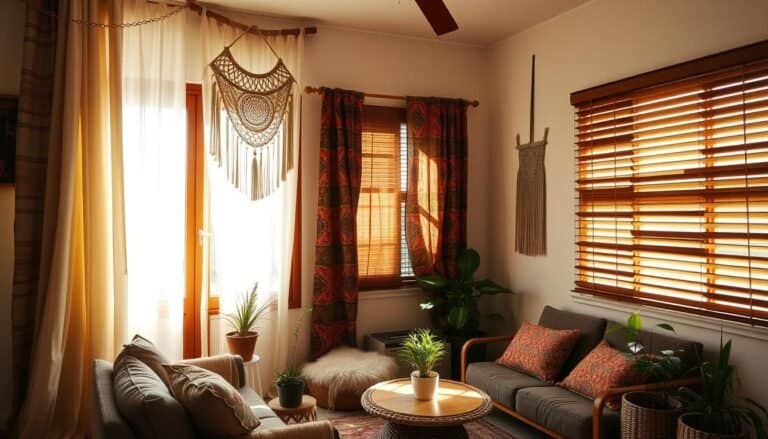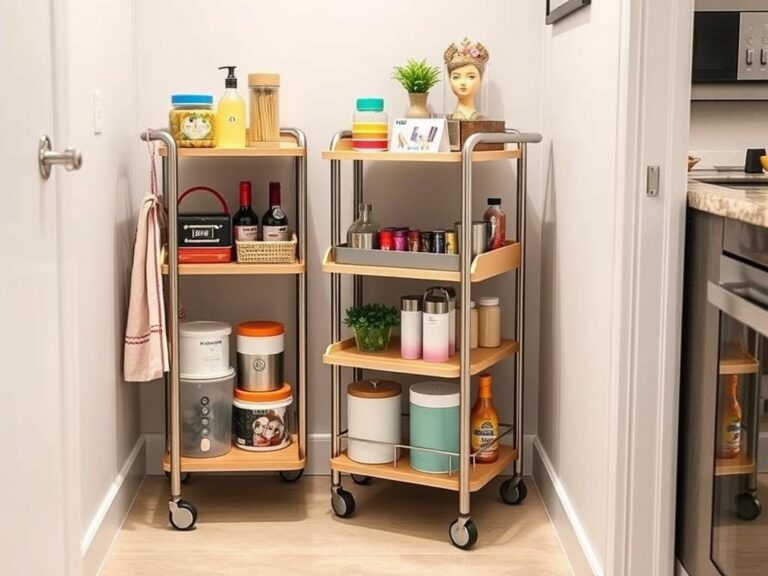Essential Boho Color Theory
This post may contain affiliate links which means I may receive a commission for purchases made through links at no extra cost to you. I only recommend products I truly believe in. Thank you for your support!
Exploring bohemian aesthetics means diving into color theory. The bohemian color scheme combines warm, earthy tones with nature-inspired colors. These colors bring a sense of freedom and creativity, perfect for a free-spirited lifestyle.
Colors like terracotta, mustard yellow, emerald green, and sapphire blue show the beauty of mixing different hues. This palette is a key part of boho style.
The heart of essential boho color theory is mixing textures, patterns, and cultural influences. This creates a space that’s truly yours. Bohemian interiors mix bold colors with calm backgrounds. This blend makes spaces both lively and peaceful.
Whether you love Moroccan charm or global vibes, understanding bohemian color theory is key. It helps you create a unique, stunning bohemian space. Explore boho colors and make a space that shows your free spirit.
Introduction to Boho Color Theory
Exploring bohemian aesthetics and boho design principles means celebrating your individuality. It’s about mixing textures, patterns, and color importance in boho in a way that’s both free and visually stunning. This style’s color palette creates a calm, inviting space.
What is Bohemian Aesthetics?
Bohemian aesthetics is about living an artistic, unconventional life. It’s all about mixing earthy tones, bright jewel colors, and soft pastels. This mix lets you express yourself freely, making your space feel unique and full of charm.
Importance of Color in Boho Design
In boho design principles, color is key to setting the mood. The boho color palette includes warm earths like terracotta and camel, along with rich browns and creamy whites. Jewel tones like emerald green and sapphire blue add depth. Vibrant colors, metallics, and natural elements bring it all together, making the space visually engaging.

By focusing on importance of color in boho design, you can make spaces that feel both curated and personal. These spaces are cozy and inviting, perfect for relaxing and expressing yourself.
Key Color Palettes in Boho Interiors
Boho interiors are known for their wide range of colors. These colors, from vibrant to earthy, make spaces warm and inviting. Let’s look at the main color palettes that make up the bohemian style.
Earthy Tones
Earthy tones are the heart of boho design. Colors like terracotta, camel, and deep browns create a cozy base. These colors connect us to nature, setting the bohemian vibe.
Vibrant Accents
Vibrant colors bring boho interiors to life. Jewel tones like emerald, sapphire, and amethyst add drama and luxury. These bold colors are used in textiles and decor to enhance the boho look.
Pastel Hues
Pastel colors like soft pink, mint green, and pale yellow add a romantic touch. They balance the richer colors, making the space visually appealing.
Designers blend these colors to create various boho styles. From Moroccan to Scandinavian, the possibilities are endless. This flexibility lets designers create unique, personalized spaces.

Incorporating Textures with Color
In the world of boho design, textures are key to enhancing colors. Fabrics like soft wool, shiny silk, and rich velvet add depth and feel to any space. They blend perfectly with the boho style.
Layering colors and textures is crucial for the boho look. Plush rugs, cozy throws, and interesting wall hangings create a warm, inviting atmosphere. This is what makes a space truly boho.
The Role of Fabrics
Fabrics are the heart of boho design. Each material brings its own unique feel to the space. From the softness of cotton to the rustic charm of linen, fabrics greatly impact the room’s feel.
Layering Colors and Textures
Layering colors and textures makes a boho space visually stunning. Mix earthy rattan and jute with plush velvet pieces. Add vibrant embroidered textiles for a bohemian touch. This mix of materials and colors is what makes boho interiors special.
| Fabric | Contribution to Boho Design |
|---|---|
| Cotton | Soft, natural feel |
| Linen | Warm, rustic charm |
| Wool | Adds depth and tactile interest |
| Silk | Lustrous, luxurious touch |
| Velvet | Sumptuous, inviting texture |
Color Psychology in Boho Decor
Color psychology is key in boho spaces. Warm colors like red, orange, and yellow make a place feel cozy. Cool colors like blue, green, and purple bring calm and peace.
How Colors Influence Mood
In boho design, colors are mixed for a perfect balance. Earthy tones like terracotta, olive green, and mustard yellow bring comfort and a nature feel. Jewel tones such as emerald, sapphire, and amethyst add elegance. Neutrals and whites like beige and gray let bold colors shine.
Popular Color Combinations
Here are some top color combos in boho decor:
- Earthy tones with jewel accents, for a rich look
- Pastel hues with metallic touches, for glamour
- Warm neutrals with vibrant pops of color, for balance
These colors aim to bring comfort, creativity, and self-expression. They help create spaces that show off a person’s personality. This way, spaces can feel full of joy, relaxation, and artistic flair.

Seasonal Color Trends in Boho Style
The boho style changes with the seasons, using bright colors. It shows the beauty of each time of year. This makes boho fashion and decor always new and exciting.
Spring and Summer Colors
In spring and summer, boho gets bright and cheerful. Colors like lemon yellow, coral, and sage green are everywhere. They bring a fresh, lively feel to boho style.
Fall and Winter Shades
When it gets cooler, boho turns to deeper colors. Shades like burgundy, forest green, and warm browns are popular. These colors add warmth and coziness to the colder months.
It’s easy to change up your boho look with the seasons. Just swap out accessories and textiles in the right colors. This keeps your boho style fresh and connected to nature’s cycles.

Utilizing Natural Elements in Color Choices
Boho-inspired interior design relies heavily on natural elements for its color palette. Plants and natural materials bring a unique, free-spirited vibe to spaces. This makes boho spaces feel inviting and full of life.
Plants and Greenery
Plants are a key feature of boho design. Succulents, ferns, and hanging plants add vibrant colors and life. They blend well with the earthy tones and bright accents typical of boho style.
Natural Materials and Their Colors
Boho design loves natural materials for their beauty and colors. Warm wood, rich leather, and organic textures like rattan and jute create a cozy atmosphere. Mixing these materials with different textures adds visual interest.
Using natural elements in boho design makes spaces feel connected to nature. The colors and textures of these elements enhance the space’s look. This makes your boho space a true reflection of the natural world.
| Natural Element | Color Palette | Textural Qualities |
|---|---|---|
| Wood | Warm browns, honey tones, natural grains | Smooth, rustic, weathered |
| Rattan | Earthy neutrals, warm ochres, natural beiges | Woven, organic, textured |
| Leather | Rich camel, cognac, saddle tan | Smooth, supple, aged |
| Jute | Neutral beige, natural fibers, earthy tones | Coarse, textured, woven |
| Succulents | Soft greens, dusty pastels, vibrant hues | Fleshy, sculptural, hardy |
| Ferns | Lush emeralds, deep forest greens, soft sage | Delicate, feathery, verdant |
Creating Harmony with Color in Spaces
To achieve color harmony in boho spaces, balance bold and neutral shades. Start with a neutral base for walls and big furniture. Then, add bold colors through accessories and small pieces. This keeps the space looking good and cohesive.
Balancing Bold and Neutral Shades
When balancing boho colors, mix neutral tones like beige, cream, or sage green with vibrant colors. Neutral shades calm the space, while bold colors add energy.
Zone-by-Zone Color Planning
Zone color planning is key in boho homes. Use different color palettes for each zone. For example, the living room might have warm earth tones with jewel-toned accents. The bedroom could have softer, soothing colors.
| Zone | Color Palette | Recommended Hues |
|---|---|---|
| Living Room | Warm Earth | Terracotta, mustard, olive green |
| Bedroom | Serene Sky | Soft blue, lavender, dusty rose |
| Dining Room | Jewel Tones | Emerald, sapphire, amethyst |
| Outdoor Space | Colorful Oasis | Fuchsia, tangerine, teal |
By balancing boho colors and planning each zone’s color, you create a stunning boho space. It shows off your style and preferences.
Conclusion: Embracing the Essential Boho Color Theory
Exploring bohemian color theory shows us the importance of balance. We need earthy tones, vibrant colors, and soft pastels. Start with a neutral base and add textures, patterns, and natural elements that show your style.
Final Tips for Effective Boho Design
Boho is about expressing yourself, so mix cultures and colors boldly. Use natural materials like wood and rattan for an organic look. Good lighting is key to a warm, welcoming space.
Invitation to Experiment with Colors
Boho design is all about being flexible and personal. Try colors that speak to you, from earthy tones to bright accents. Mix them, change your colors with the seasons, and let your creativity flow. It’s about celebrating your unique style and making a space that reflects you.




